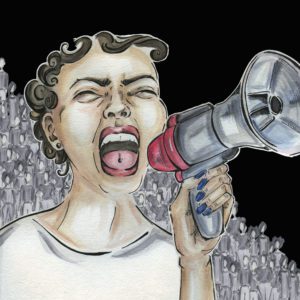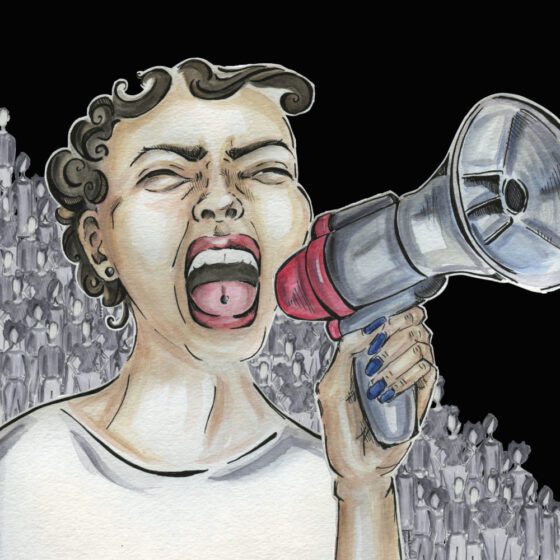
ENOUGH is a Rumpus series devoted to creating a dedicated space for essays, poetry, fiction, comics, and artwork by women and non-binary people that engage with rape culture, sexual assault, and domestic violence.
The series will run every Tuesday afternoon. Each week we will highlight different voices and stories.
***
Rescue Me
Karen Stefano
It’s the middle of summer, almost midnight, when I leave my job on the UC Berkeley campus. I sling my lavender backpack over my shoulder and begin the walk home alone in darkness.
At my gloomy street I pivot, turn right. Overgrown bushes encroach grimy sidewalks, a long expanse of darkness with only a few dim streetlights. There is no sound but my footsteps, my worn white flats carrying me home. I reach my building and turn inside the concrete tunnel-like hallway leading from the sidewalk into the base of the building. The gold overhead light mutes the edges of color, turning everything inside the hall a bronzy gold.
Halfway through, almost to my front door, I hear feet slapping concrete, the sound of someone jogging. I hesitate, turn to look and assess, see a man in blue jeans on the sidewalk running down my street with his head down, about to pass the threshold of my hallway. I catalogue him: Nerdy grad student. Squinty light eyes. Social prospects thin as his pale hair. He has nothing to do with me. This is Berkeley. A man trotting down a dark empty street in the middle of the night is nothing unusual. I discard him, turn back, satisfied, ready to be home.
But the footsteps change course.
I spin around again as his head rises, blue eyes locking on mine. They are wild eyes, blazing eyes that tell a story, the story of what will happen next. I feel them consume me and I swallow their meaning. My stomach flips, sends electrical current straight up to my heart, and everything inside me goes still. No, I think. No!
Then I see the knife.
It glints beneath the light from the hallway bulb, brass and wood in the palm of his hand. We see only each other as I back away. His eyes are focused, hard, intended only for me. The knife, gleaming beneath the light, is intended only for me.
A visible hunger rushes through his face and in the next instant he has me, pulled inside the trap of his arms in one fluid movement. Our dance is fast, a spin, as he catches my back to his chest and my fear turns savage as his fingers close on my mouth. Under his skin is muscle, bone. Under mine, rapid-fire heartbeat. I wiggle and writhe, but he holds tight, an offbeat wormy dance. My mind registers powerful shoulders, the placement of each thick finger. It’s only us now. No one else exists.
He holds me tight against him, my back pressed to his chest, his crotch to my ass, hand groping at my mouth while the other brings the knife to my throat. Both of us breathe, heaving breaths like dancers frozen in the final spotlight.
A newly declared psychology major, I recall Psych 101 and learning about twenty-eight-year-old Kitty Genovese who in 1964 was stabbed to death outside her Queens apartment building when returning home from work in the middle of the night. We were told that thirty-eight witnesses saw the attack or heard her screams and not one of them called the police. This woman’s fate flickers through my mind as I face my dilemma: scream and he will cut my throat and no one will rescue me anyway. Don’t scream and I am his.
Kitty Genovese was stabbed, raped, and murdered. According to initial newspaper accounts the attack lasted at least thirty minutes, during which time Genovese screamed and begged for help. Her assailant, Winston Moseley, charged Genovese and stabbed her, then fled the scene, then returned ten minutes later and completed his attack. Public opinion of the story crystallized around an article’s quote from a neighbor who witnessed part of the attack but hesitated before finally urging another neighbor to call the police, saying, “I didn’t want to get involved.” Many saw the story of Genovese’s murder as emblematic of the callousness of life in big cities.
The Genovese case prompted experiments documenting the social phenomenon that came to be known as the bystander effect—the circumstances whereby people are less likely to help a victim when other people are present. The bystander effect has been attributed to a “diffusion of responsibility,” where witnesses are less likely to intervene because the presence of others lets us assume someone else will act. Another factor is “social influence,” where individuals in a group assess the behavior of those around them: if onlookers see that others aren’t helping either, they feel more comfortable not acting themselves.
Contextual ambiguity is another factor contributing to the bystander effect. In situations where passersby are unsure whether a person really needs help, reaction time is slow. In low ambiguity situations reaction times are quicker. Researchers studied people’s reactions to a man and woman fighting in the street. When the woman yelled, “Get away from me—I don’t know you!” bystanders intervened sixty-five percent of the time. But when the woman shouted, “Get away from me—I don’t know why I ever married you!” bystanders intervened only nineteen percent of the time.
In another study, psychologists had students walk across campus to give a talk. On the way, the students encountered a study confederate, slouched over and groaning in a hallway. Their response depended prominently on a single factor: whether or not they were late. Only ten percent of the students stopped to help when they were in a hurry. More than six times as many intervened when they had plenty of time before their talk.
Another variable contributing to the bystander effect is the characteristics of the victim. People are more likely to help those they perceive as similar to them, including individuals from their own racial or ethnic groups. Generally, women will receive more help than men. But this varies according to appearance: more attractive women tend to receive more help from bystanders.
My assailant is serious. He is strong, powerful, and our dance turns clumsy. My white flats feel silly now, slippery soles sliding on the concrete, legs lifting off the ground, turning me weightless. Face tilted upward I see the gold-lit ceiling of the hall, concrete and stucco. It is dusty, dirty, brushed with cobwebs. Terror strangles my throat, clogs it. Words slide through my mind. Ineffectual. Helpless. Can’t even stand on my own two feet. Those feet keep flying into the air, running to get away while my body stays pressed in place against him. I am like some hapless cartoon character.
Facts. I weigh a hundred ten pounds and am five feet two inches tall. I am not athletic. I lack coordination. I am easy prey. Somewhere inside these facts tally. Somewhere inside I admit defeat.
His hand on my mouth hurts. Too tight, too close. The salty taste of his humid skin, the heaving breath beneath my back, his chest rises and falls, rises and falls. The musky smell of his sweat, the scent of my fear. For a moment we are motionless in our awkward embrace. Every fraction of a second is a beat in time that seems to stretch out forever. Everything is amplified, every sense is pulsing and I’m aware that I have never been so on the brink of losing myself. My soul shivers.
Together we breathe. We don’t speak. There are no words. It’s so direct. A different social code. No awkwardness, our roles are clear. There is a strange intimacy, as if we can read each other’s minds, both of us debating our next move as the hallway light leaves us layered in color.
Arms still pinned to my sides. I buck and thrash again, trying to break loose. He staggers beneath my back but doesn’t lose hold. He grips harder. My backpack falls from my shoulder, slams to the ground. It sits there. It is not what he wants. Time stops.
Decades later, investigations revealed there were not thirty-eight eyewitnesses to the stabbing of Kitty Genovese. The police were contacted at least twice during the attack. Because of the layout of the complex and the fact that the attacks took place in different locations, no witness saw the entire sequence of events. Several neighbors heard Genovese yell but only a few recognized the sound as a cry for help. Many thought they had heard drunks or lovers quarreling. It was when one of the neighbors shouted “Let that girl alone!” that Moseley initially ran away. Genovese then stumbled toward the rear entrance of the building, seriously wounded and out of view of witnesses. After the first attack punctured her lungs, leading to her eventual death from asphyxiation, it’s doubtful Genovese could scream at any volume.
Still, a review of ten leading undergraduate textbooks found the Genovese case in all of them, with eight books suggesting that witnesses watched from their windows as Genovese was murdered. Many have suggested that the story continues to be misrepresented in psychology textbooks because it presents a dramatic example for readers. Dramatic enough to flicker through my mind during my own assault.
The truth of what happened the night of Genovese’s murder may not have lined up with news reports, but the fact that we often choose to look away in the face of trouble remains a cruel reality. In early 2010, homeless Hugo Alfredo Tale-Yax witnessed a woman being attacked by a knife-wielding assailant in Queens. Tale-Yax intervened and saved the woman, getting stabbed multiple times himself in the process. He lay dying in a pool of his own blood for more than an hour as dozens walked by. In 2011 a two-year-old girl, Wang Yue, was hit by a van in Foshan, China, then run over by a truck when she was not moved by bystanders. Eighteen people ignored her, some going so far as to walk around the blood. Seven minutes passed before a bystander picked her up and called for help. She died eight days later. In 2017 half a dozen teen boys lured a fifteen-year-old girl to a house in Chicago where they brutally and repeatedly sexually assaulted her. Her attackers streamed their crime on Facebook Live. Forty people watched the young woman’s assault in real time. Not one of those viewers picked up the phone to dial 911.
But often bystanders do intervene and come to the aid of their fellow beings, most notably the instance of the Stanford rape survivor and the two Swedish students who found her and chased down her assailant, Brock Turner. Or the passengers who in 2015 subdued a would-be terrorist armed with an AKM assault rifle on a Thalys train en route to Paris. Or the seventh grade heroes who sprang into action when their school bus driver had a heart attack, grabbing the wheel and steering the bus to safety.
Most of us consider ourselves moral, assertive beings and yet we humans routinely witness bullying or harassment and do nothing. We rush past homeless people and do nothing. We notice litter on the sidewalk and leave it for someone else to pick up. Every day we serve as bystanders to social and political issues that impact all of us. Maybe we fail to act because we feel powerless.
All of us have the potential to fall into the rank of bystander versus the rank of morally courageous. Research seems to prove it’s the small, seemingly inconsequential details of a situation that push us one way or the other. We may never know how we’ll act until we find ourselves in a crisis.
The bystander effect is not a one size fits all phenomenon. Sometimes it happens, sometimes it doesn’t, all depending on the intricacies of the situation. My own unscientific take: we humans are complicated beings, a tangling of contradictions and insecurities and fear. We are preoccupied with our careless lives, addicted to staring at tiny screens, content to remain blissfully unaware. People in need are messy, ugly even. It’s unnerving to find oneself in the proximity of misfortune. It triggers the percolating fear that others might infect us with their loss. It’s as if we feel tragedy is contagious. We don’t want to be reminded of our own vulnerability, of the simple truth that disaster can strike at any moment, anywhere. Even at the threshold of home.
Inside the bronzy gold light of my building’s hallway, facing my dilemma, my assailant’s hand moves somehow and suddenly there is no uncertainty. My mouth opens, a throat fills. There is a voice. It is mine.
I have had dreams. Nightmares where I open my mouth and no sound comes out. But what is flung from my body is a primal sound, a noise that echoes and bounces off the walls, amplified into the apartments behind and above mine, flying up into the night. The debate was no debate at all. This sound that emerges is involuntary. Me, so used to controlling my voice, to lowering it an octave to exert my power, my control, my authority over those around me, so desirous of dictating how others hear and perceive me. This sound knows nothing of control. I’ve unleashed a blood-curdling sound, a sound that feels like it has come from someplace else. They are the screams of a woman fighting to stay alive. Terror, I realize, has a sound.
The man’s muscles jump beneath my back. A shift in the atmosphere, in the dynamic of this dance, this clumsy embrace. A moment of indecision, the pulsing what next? firing off in unison in our brains. I feel a change, a hesitance now, the weight of the decision he has to make. It vibrates inside him. His own debate: slice my throat? Drag me with him? Dump me? Run? His hand fights to cover my mouth and I writhe out from under that hand and scream again. Bloody murder is the name of the sound. Someone needs to hear.
I have shattered the silence of the night, the screams hurtling through darkness. Doors fly open, swinging on hinges. Somewhere, stunned voices yelling, Jesus Fuck. The spell is broken. My assailant breaks away, pushing off me like a swimmer launching from a deck for speed, causing my body to scrape the wall. Gravity wins. I fall. From the ground I watch him, absorb his sound. Footsteps retreating into darkness.
The reaction of these unknown neighbors—strangers every one—caused my assailant to flee, leaving me physically unharmed.
The myth of Kitty Genovese’s thirty-eight apathetic bystanders did not dissuade my body from unleashing its screams, nor did the attacker’s knife. What I learned from my assailant, what I came to promise myself: if you’re ever faced with the fleeting decision to fight or submit?
Fight.
So many years later I still ponder the parallels between the assault and murder of Kitty Genovese and my own attack. Both of us women coming home alone from work late at night because—what the hell else are you supposed to do? I ask myself questions about our respective assailants: Was Moseley waiting for Genovese as she parked her car and walked toward her apartment building? Had he watched her before? Was he waiting for her? Or would any woman do? And my assailant—had he watched me before? Was he waiting in the shadows for me? Or would any victim have satisfied his need? What compelled these monsters to pick up their knives and move out into the night to hunt their female prey?
But these are questions that hold no answers.
In the days, weeks, months following my assault —somewhere inside I knew something. Nothing else in the world had changed. Only me. A young woman had been consumed in those minutes in that hallway. She had been spit back out in a different form. Her strength had been stripped and she grew bewildered. What does the world mean when you no longer trust it?
Every ounce of my confidence was stripped away. Inside my body something invisible quaked and raged. I fought, pushed it down, but inside the unbridged emptiness my ambient fear pulsed deeper. The world turned tattered, frayed, worn, ugly. My place within it seemed tentative.
I never got counseling following my assault. I tried to bury it mentally. I had classes to attend, papers to write, shifts to work. But some days all I could do was sit shivering inside my crappy apartment with its cinder block walls and thin brittle windows that I suddenly realized offered little barrier to burglars, rapists, or men holding knives. I sat inside those walls hoping for the best and expecting the worst.
Sometimes calamity arrives, rearranges our universe, our world view, the meaning we give to everything around us. Sometimes it leaves a mark. Trauma, quite simply the pain and shock of an intense memory that alters your life in a significant way, is something that changes who you are, how you see the world and the people who inhabit it. Fear makes you a stranger to yourself.
***
Rumpus original logo art by Luna Adler.
***
ENOUGH is a Rumpus original series devoted to creating a dedicated space for work by women and non-binary people that engages with rape culture, sexual assault, and domestic violence. We believe that while this subject matter is especially timely now, it is also timeless. We want to make sure that this conversation doesn’t stop—not until our laws and societal norms reflect real change. You can submit to ENOUGH here.
Many names appearing in these stories have been changed.
Visit the archives here.


